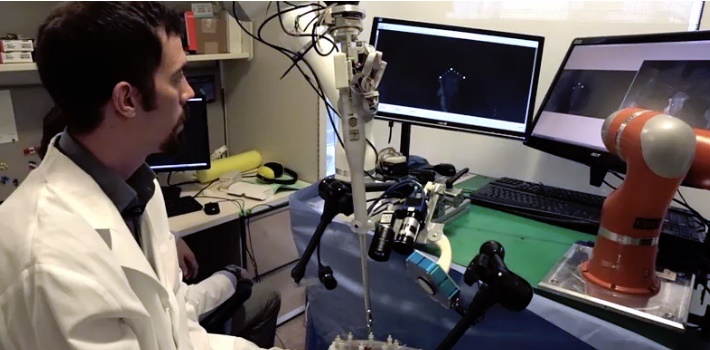A robot has made a bug news by successfully operating the guts of a pig. Yes, the robot is a fully equipped surgeon who did an amazing surgery with little guidance from its mentors- the group of researchers working on it. Sewing guts is one of the most difficult operating that needs high level of efficiency and flexibility. It has been found that the robot was able to accomplish the operation with a precision that exceeded even that of a human surgeon.

The robot is not yet fully automated and completes its stitches only after approval of its human mentor. The study was published in the journal Science Translational Medicine. The researchers say that the automated operation is only a proof-of-concept and requires more research and development before it becomes safe for humans. The robotic operations that are prevalent currently are rarely used because the methods are highly criticized for being expensive but not safer than human conducted operations.
Scientist Peter Kim, the lead author of the paper said that their main aim is to create a fully autonomous robot surgeon that will be operate all by its own. In future an environment will be created when bots and humans will work together in delivering some of the toughest operations. He gave another insight of their project. “Take Mr. Elon Musk as an example,” said Kim “Planning to go to Mars for 18 months, and then 18 months coming the other way!” If Musk or astronauts like him need an emergency surgery, then what will happen? The only answer is autonomous surgery.

The technologies that will be needed are advanced vision, Smart Tissue Autonomous Robot or STAR that will track movement of flesh. Several fluorescent dots were injected into the pig’s tissue which were then again tracked by an array of cameras and mapped onto a 3D model. Software application containing compiled data on past history of operations and surgeries. After analyzing the data, the bot will decide where and how to place the stitches. then decides where to place the stitches on this 3D model. The system so designed allows the robot to track the tissue as it bends and flexes. The robot will follow the fluorososcent dots but at present the dots still have to be placed by a human operator.
Check out the abstract:
The current paradigm of robot-assisted surgeries (RASs) depends entirely on an individual surgeon’s manual capability. Autonomous robotic surgery—removing the surgeon’s hands—promises enhanced efficacy, safety, and improved access to optimized surgical techniques. Surgeries involving soft tissue have not been performed autonomously because of technological limitations, including lack of vision systems that can distinguish and track the target tissues in dynamic surgical environments and lack of intelligent algorithms that can execute complex surgical tasks. We demonstrate in vivo supervised autonomous soft tissue surgery in an open surgical setting, enabled by a plenoptic three-dimensional and near-infrared fluorescent (NIRF) imaging system and an autonomous suturing algorithm. Inspired by the best human surgical practices, a computer program generates a plan to complete complex surgical tasks on deformable soft tissue, such as suturing and intestinal anastomosis. We compared metrics of anastomosis—including the consistency of suturing informed by the average suture spacing, the pressure at which the anastomosis leaked, the number of mistakes that required removing the needle from the tissue, completion time, and lumen reduction in intestinal anastomoses—between our supervised autonomous system, manual laparoscopic surgery, and clinically used RAS approaches. Despite dynamic scene changes and tissue movement during surgery, we demonstrate that the outcome of supervised autonomous procedures is superior to surgery performed by expert surgeons and RAS techniques in ex vivo porcine tissues and in living pigs. These results demonstrate the potential for autonomous robots to improve the efficacy, consistency, functional outcome, and accessibility of surgical techniques.
Source: Science Translational Medicine







Leave a Reply